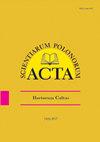Investigating the impact of TiO2 nanoparticles on bioactive compounds in sweet pepper seedlings: a comparison of foliar and root application methods
IF 0.7
4区 农林科学
Q4 HORTICULTURE
引用次数: 0
Abstract
Engineered TiO2 nanoparticles (TiO2-NPs) are broadly produced and utilized in various consumer products. However, plant uptake of NPs may lead to disruptions in physiological and metabolic processes, particularly when the plant’s defense mechanisms are overwhelmed. In this study, sweet pepper seedlings were exposed to TiO2-NPs via foliar (2.5% suspension) and root (0.5% suspension) methods, with plants treated with distilled water serving as controls. Results showed that foliar application caused higher accumulation of Ti in leaves as compared to stems, while root exposure led to a higher increase of Ti content in stems than in leaves. Additionally, foliar application led to alterations in chemical composition of the plants, including changes in malondialdehyde (MDA), L-ascorbic acid, total phenolics content, carotenoids, in total antioxidant capacity (TAC) and antioxidant enzymes activity. Root exposure also affected enzyme activity and TAC, but also altered H2O2, MDA and glutathione content. Chlorophylls remained at stable level in the leaves of the seedlings. Overall, these studies provide important information on plant-nanoparticle interactions and the potential effects of different nanoparticle application strategies. These data indicate also that the specific nanoparticles, applied at a controlled manner, have potential to boost the plant metabolism and improve stress tolerance, which is an important factor affecting crops’ quality and productivity.TiO2纳米颗粒对甜椒幼苗中生物活性化合物的影响:叶面和根部施用方法的比较
工程TiO2纳米颗粒(TiO2 NP)广泛生产并用于各种消费品。然而,植物对NP的吸收可能会导致生理和代谢过程的中断,尤其是当植物的防御机制不堪重负时。在本研究中,甜椒幼苗通过叶面(2.5%悬浮液)和根部(0.5%悬浮液)方法暴露于TiO2 NP,用蒸馏水处理的植物作为对照。结果表明,与茎相比,叶面施用导致叶片中Ti的积累更高,而根系暴露导致茎中Ti含量的增加高于叶片。此外,叶面施用导致植物化学成分的变化,包括丙二醛(MDA)、L-抗坏血酸、总酚含量、类胡萝卜素、总抗氧化能力(TAC)和抗氧化酶活性的变化。根暴露也影响酶活性和TAC,但也改变了H2O2、MDA和谷胱甘肽含量。幼苗叶片中的叶绿素保持在稳定水平。总之,这些研究提供了关于植物-纳米颗粒相互作用和不同纳米颗粒应用策略的潜在影响的重要信息。这些数据还表明,以可控的方式施用特定的纳米颗粒,有可能促进植物代谢和提高抗逆性,这是影响作物质量和生产力的重要因素。
本文章由计算机程序翻译,如有差异,请以英文原文为准。
求助全文
约1分钟内获得全文
求助全文
来源期刊
CiteScore
1.30
自引率
14.30%
发文量
61
审稿时长
4-8 weeks
期刊介绍:
In Acta Scientiarum Polonorum Hortorum Cultus we publish original research papers and review articles containing new and significant information on broad aspects of horticulture and related disciplines. The papers are published in English only, in six issues yearly.

 求助内容:
求助内容: 应助结果提醒方式:
应助结果提醒方式:


